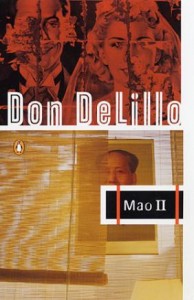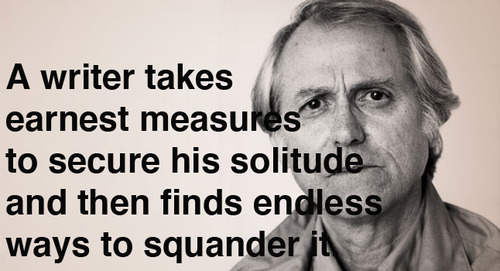The more I read (and reread) Don DeLillo‘s work, the more convinced I become that, in his lifetime, he has come up with one plot idea. That’s one reason I’m lumping these two books together. I’ve read both of them before: Point Omega twice, now, and Mao II four times. (Yes, four. And it’s not even DeLillo’s best novel.) They’re basically the same story, just at different parts on the continuum.
Talking about the general subject of my thesis was not the plan, but here’s how DeLillo seems to work. I’ve summed it up at least once on this blog, but I’ll expand more because I’ve discovered that they aren’t all exactly the same story, just a bunch a of stories that follow the same plot. Which is essentially the same story.
Keep in mind that I’m writing this post off the top of my head and without any of these books in front of me.
It started with Americana. A young man in advertising decides that he wants out of the visual consumer culture in which he has been immersed since childhood, so he takes a road trip across the country to escape it. Some interesting things happen, and he ends up back in New York, probably doing the same thing. He hasn’t changed much, just realized that he can’t escape media culture.
End Zone, DeLillo’s second novel, only occupies a vague back corner of my head, but an up-and-coming college football player continually flunks out (or gets in trouble or something) and ends up at a small college in the desert (along with motel rooms, DeLillo’s favorite place). He escapes the limelight, but I don’t really remember what happens after that. I’m sure he returns to it.
Then there’s Great Jones Street, considered by many DeLillo’s worst novel, but one of my favorites. Bucky Wunderlick, a 25-year-old but old and strung out musician gets tired of being spun on the media-driven market like the records he produces, so he holes up in a hotel, hiding from the world. He accidentally gets mixed up in what basically amounts to a mob war, in which he keeps a superdrug in his hotel room, then ends up being forced to take it himself. It takes away any language in his head, but eventually everything comes back. He returns to media-saturated culture.
Then there’s a string I haven’t read, including Ratner’s Star, about science, which I think I should have liked but that I couldn’t finish…but I digress.
There’s The Names, which I didn’t like, but it’s about the power of language. Someone escapes ye olde media-saturated culture and ends up in Greece, where there’s a language cult. Things go badly. I remember about as much about The Names as I do End Zone, so I’ll stop there.
Then there’s White Noise, arguably DeLillo’s best novel, about a professor at a small college on the run from an Airborne Toxic Event caused by a train derailment. He and his family evacuate and then return, and they’re affected by the media response to the event. There are gas cloud drills, and such. The sunsets in his town are amazing and beautiful because of what they’ve done to the environment: which essentially means that it’s artificial and not authentic, another of DeLillo’s favorite themes. And the lists! White Noise contains some of DeLillo’s best lists. You can read examples from White Noise and Americana in this very early blog post. That’s only grazing the surface of White Noise. If you haven’t read it, get a copy.
Next is Libra, about Lee Harvey Oswald killing JFK and the conspiracy surrounding it, commercialized and commodified by guess what? media-saturated culture. Are you seeing the trend? Media drives him crazy.
 And good ol’ Mao II, which I’m pretty sure I’ve read more than any other novel ever, about a writer who is tired of being commodified by the media, so he goes into seclusion for a couple of decades before he starts to feel trapped and wants to put himself out there again. In his case, his efforts are too little too late, and he ends up dead on a ferry between Cyprus and war-torn Beirut. That’s the third book in the thesis.
And good ol’ Mao II, which I’m pretty sure I’ve read more than any other novel ever, about a writer who is tired of being commodified by the media, so he goes into seclusion for a couple of decades before he starts to feel trapped and wants to put himself out there again. In his case, his efforts are too little too late, and he ends up dead on a ferry between Cyprus and war-torn Beirut. That’s the third book in the thesis.
I’ve only gotten through about a quarter of Underworld (I’ve tried twice and just can’t do it), another contender for DeLillo’s Best Book. It involves the desert, at least.
I really disliked The Body Artist and have apparently repressed any memory of it, but I’m sure it’s the same thing. I just broke down and ordered a copy, though I was sure I owned it.
Then, there’s Cosmopolis. You might have seen the recent movie starring That Sparkly Kid from the Twilight Movies. I didn’t, and I have exactly zero interest. I didn’t even like the novel. But it follows the trend! Here’s how I summed up Cosmopolis in a previous blog post: “A guy (always a guy: DeLillo writes Man Novels) experiences some sort of postmodern angst related in some way to the media. He runs away from his life or otherwise destroys it. Sometimes he attempts to return and is unsuccessful in reintegrating himself.” Another one I’ve repressed, but it’s about a young man in New York who goes crazy because of media-driven culture and rides around in a limousine (not even to the desert!) for a while, and then things go south quickly.
Next (I’m almost done!) is Falling Man, about how a man reacts to the media’s reaction to 9/11. Same thing again.
 Finally, there’s Point Omega, which I just reread. Here’s where the continuum idea comes in: In Americana dude goes on a road trip and ends up in the desert, then back because he gives up. Mao II picks up at the attempted reintegration into consumer society, and the writer in that book fails miserably. In Point Omega, the protagonist was fairly good at reintegration – he was a professor, went out to the desert, came back, and worked for the government for a while. He ended up back in the desert, but not dead – yet. This time, he isn’t hiding: he has a cell phone and has allowed a filmmaker to make a documentary about him (yes, totally reminiscent of Americana and Brita’s photo shoot in Mao II). This time, the world comes after him. His daughter comes to visit and then disappears. He doesn’t deal well with said disappearance, and he withdraws into himself, a sort of final withdrawal that will end in a death similar to but at the same time very different from Bill Gray’s in Mao II. Here, the attempt is not to return to society: the protagonist here is done, but even after he’s put his time in, he still can’t escape his culture. He ends up going back to New York without his daughter, but he’s withdrawing, not reemerging this time.
Finally, there’s Point Omega, which I just reread. Here’s where the continuum idea comes in: In Americana dude goes on a road trip and ends up in the desert, then back because he gives up. Mao II picks up at the attempted reintegration into consumer society, and the writer in that book fails miserably. In Point Omega, the protagonist was fairly good at reintegration – he was a professor, went out to the desert, came back, and worked for the government for a while. He ended up back in the desert, but not dead – yet. This time, he isn’t hiding: he has a cell phone and has allowed a filmmaker to make a documentary about him (yes, totally reminiscent of Americana and Brita’s photo shoot in Mao II). This time, the world comes after him. His daughter comes to visit and then disappears. He doesn’t deal well with said disappearance, and he withdraws into himself, a sort of final withdrawal that will end in a death similar to but at the same time very different from Bill Gray’s in Mao II. Here, the attempt is not to return to society: the protagonist here is done, but even after he’s put his time in, he still can’t escape his culture. He ends up going back to New York without his daughter, but he’s withdrawing, not reemerging this time.
(There’s also a collection of short stories that’s very spotty, called The Angel Esmeralda, which I’m not going to address because in most cases, DeLillo’s stories are too short to fit the mold, and that’s a good thing.)
That was certainly a spiel – and certainly not what I intended. It reminds me of why I like writing on this blog and why I hate writing for any other purpose: I can just spew out what I want to say without having to prove specific statements or even organize it very well. What I hope you take away is that I’ve expanded my view of DeLillo’s books. It’s still all one big story, but at least he seems to be progressing to later parts of said story. It’s just taking him multiple books and a lifetime to do it.
